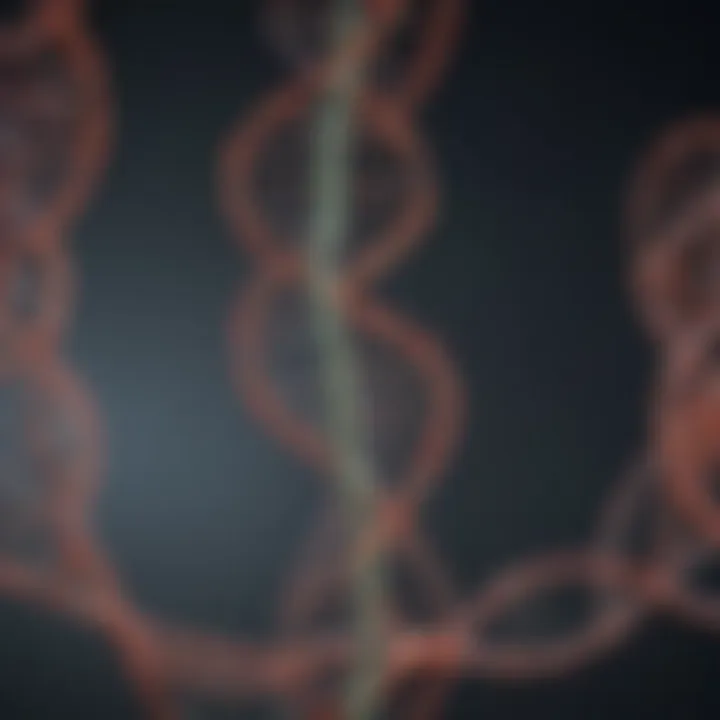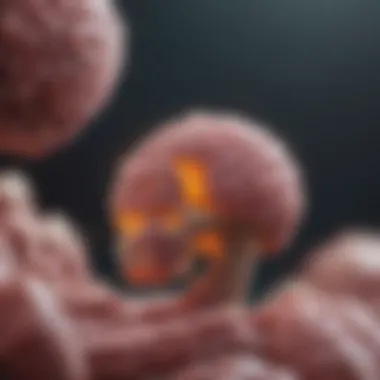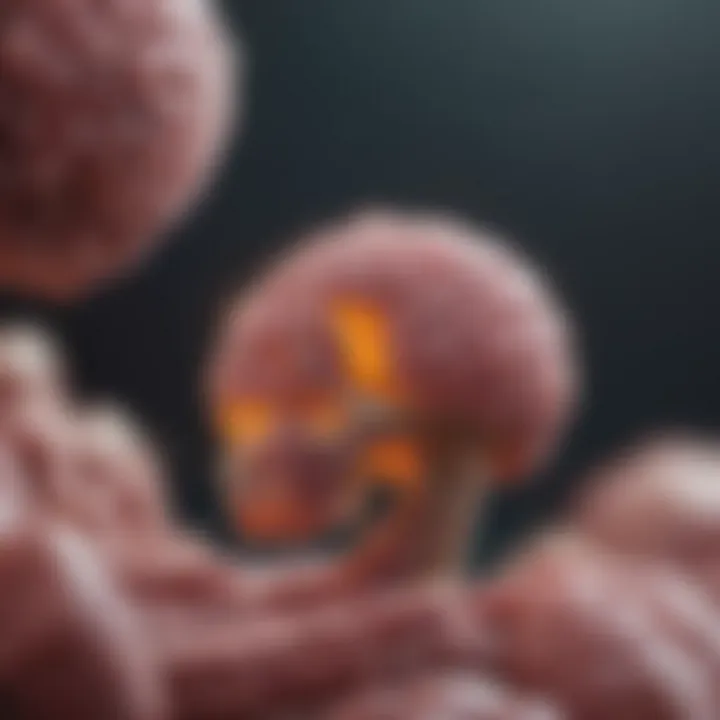Understanding eGFR Amplification in Glioblastoma


Intro
Glioblastoma multiforme is known as one of the most formidable challenges in oncology, given its aggressive nature and bleak prognosis. A pivotal factor in understanding glioblastoma is the amplification of the Epidermal Growth Factor Receptor (EGFR). This alteration frequently occurs in glioblastoma patients and is implicated in tumor progression and treatment resistance. An examination of the role of EGFR amplification sheds light on both the biological underpinnings of glioblastoma and the future of targeted therapy development.
Research Overview
Summary of Key Findings
EGFR amplification is found in approximately 40% of glioblastoma cases. This alteration drives oncogenic signaling pathways that contribute to tumor cell proliferation, survival, and invasiveness. The literature suggests that heightened EGFR activity correlates with poorer clinical outcomes. Moreover, the presence of EGFR mutations can compound the effects of amplification, leading to further complexities in treatment response.
Background and Context
Glioblastoma arises from astrocytes and represents the highest grade of glioma in terms of malignancy. The overall survival rate for patients diagnosed with glioblastoma remains dismally low, typically around 15 months post-diagnosis. Understanding the genetic landscape, specifically EGFR alterations, is crucial for optimizing therapeutic strategies. Only decades ago, glioblastoma treatment relied primarily on surgery and radiotherapy. As research progresses, targeted therapies aimed at specific molecular targets like EGFR have emerged as hopeful alternatives. However, there is a considerable gap between the promise of these therapies and their practical implementation in a clinical setting, largely due to heterogeneous tumor biology.
Methodology
Experimental Design
This analysis pulls from various empirical studies that investigate EGFR amplification in glioblastoma, utilizing both retrospective and prospective designs. It critically reviews the genetic testing methods used, including next-generation sequencing and fluorescence in situ hybridization, to ascertain the presence and extent of EGFR alterations.
Data Collection Techniques
Data for this research is collected from clinical trial registries, peer-reviewed journals, and databases such as The Cancer Genome Atlas (TCGA). Additionally, patient outcome data is aggregated from hospitals specializing in neuro-oncology. This multi-faceted approach allows for a comprehensive understanding of how EGFR amplification impacts the course of glioblastoma and influences therapeutic responses.
Understanding the dynamics of EGFR amplification in glioblastoma is not merely an academic endeavor; it holds significant implications for patient management and treatment innovations.
Prologue to Glioblastoma
Glioblastoma is a significant concern in oncology, primarily because of its aggressive nature and poor prognosis. Understanding this tumor type is imperative for advancing treatment options and improving patient outcomes. Glioblastoma, classified as a grade IV astrocytoma, is known for its rapid growth and ability to infiltrate surrounding brain tissue. This invasive characteristic complicates surgical interventions and renders conventional therapies often ineffective.
In this article, we explore the nuances of glioblastoma, particularly focusing on the potential role of epidermal growth factor receptor (EGFR) amplification in its pathology. The relationship between EGFR alterations and glioblastoma underscores the necessity for targeted therapies that can address the unique molecular profile of each tumor. By delving into this topic, we can identify promising areas for therapeutic intervention and highlight the challenges associated with glioblastoma.
Defining Glioblastoma
Glioblastoma multiforme, or simply glioblastoma, is the most common and aggressive malignant brain tumor in adults. It arises from glial cells, which are supportive cells in the central nervous system. The World Health Organization classifies glioblastoma as grade IV due to its characteristic microscopic features, which include necrosis, cellular pleomorphism, and high mitotic activity.
The genetic makeup of glioblastoma is diverse, often showcasing complex alterations, including mutations in key genes like TP53 and PTEN. These alterations contribute to the tumor's pathogenesis and progression. Moreover, glioblastomas often exhibit considerable variability between patients, complicating treatment approaches and outcomes.
Clinical Features of Glioblastoma
Clinically, glioblastoma presents a daunting array of symptoms due to its location and aggressive proliferation. Common symptoms include:
- Headaches: These are often sudden in onset and can be severe.
- Neurological deficits: Depending on the tumor’s location, patients may experience weakness, numbness, or difficulties with speech and vision.
- Seizures: Many patients present with new-onset seizures, which can be focal or generalized.
- Cognitive changes: Memory problems, personality changes, or confusion can also occur as the tumor progresses.
Diagnosis typically involves neuroimaging studies, such as MRI or CT scans, followed by histopathological confirmation through biopsy. The prognosis remains grim, with median survival rates ranging around 15 months post-diagnosis, despite aggressive treatment protocols involving surgery, radiation, and chemotherapy.
"Glioblastoma is a prime example of the complexity of cancer pathobiology, necessitating ongoing research to unravel its mechanisms and improve therapeutic strategies."
The clinical features and intrinsic aggressiveness of glioblastoma warrant a deeper examination of the genetic factors at play, particularly the role of EGFR amplification. Understanding how these factors contribute to tumor behavior is essential for developing more effective treatment modalities.
Understanding EGFR
In the context of glioblastoma, epidermal growth factor receptor (EGFR) is a critical element. It is a cell surface protein that plays a significant role in the regulation of cell processes. Understanding how EGFR functions is essential for unraveling the complexities of glioblastoma. This knowledge not only shines a light on the biological behavior of aggressive tumors but also informs targeted therapeutic strategies aimed at inhibiting this pathway. The implications of EGFR in glioblastoma extend from tumor growth to invasion and metastasis.


Role of EGFR in Cellular Functions
The epidermal growth factor receptor is a part of a signaling pathway that influences a variety of cellular functions. When EGFR is activated, it initiates a cascade of events involved in cell division, survival, migration, and differentiation. This makes EGFR particularly important in the context of cancer, where these processes are often dysregulated.
In glioblastoma, the aberrant signaling through EGFR leads to uncontrolled proliferation of cancer cells. This can result in increased tumor size and adverse effects on the surrounding tissue. Furthermore, EGFR signaling plays a role in vascular permeability and angiogenesis, allowing tumors to acquire nutrients and oxygen efficiently.
Key functions of EGFR include:
- Promotion of cell survival: Inhibits apoptosis, contributing to the longevity of cancer cells.
- Facilitation of cell proliferation: Stimulates tissues to grow and repair, which in tumor environments is often altered.
- Induction of motility: Enhances the invasive potential of glioblastoma cells.
Understanding these roles helps in devising effective treatment strategies aimed at targeting EGFR, ultimately contributing to better clinical outcomes.
Mechanisms of EGFR Activation
Activation of EGFR can occur through various mechanisms, ensuring that it is responsive to numerous stimuli in its environment. Primarily, EGFR activation involves the binding of specific ligands, such as epidermal growth factor (EGF) and transforming growth factor alpha (TGF-α). This binding leads to receptor dimerization, allowing the receptor's intrinsic kinase activity to become functional.
There are also ligand-independent mechanisms that result in EGFR activation. These include:
- Mutational alterations: Certain mutations in the EGFR gene can cause the receptor to be constitutively active, resulting in persistent signaling.
- Overexpression: Increased levels of EGFR protein can lead to heightened signaling even in the absence of ligands.
- Cross-talk with other receptors: Interactions with other signaling pathways can result in EGFR activation, as observed in many cancer types.
Through understanding these activation mechanisms, researchers can explore potential therapeutic interventions that disrupt EGFR signaling. Such efforts are crucial as the presence of EGFR amplification is associated with poorer prognoses in glioblastoma patients.
"The presence of EGFR mutations and amplifications is a key factor in the aggressive nature of glioblastoma, making it a target for innovative therapies."
By dissecting the intricacies of EGFR and its role in glioblastoma, the article paves the way for enhanced comprehension of tumor biology and treatment possibilities.
EGFR Amplification in Cancer
The topic of EGFR amplification is crucial within the context of cancer research, especially when considering its specific implications and effects on the biology of tumors. The epidermal growth factor receptor (EGFR) is a transmembrane protein that plays an important role in regulating cell division and survival. When amplified, EGFR's functionality may become aberrant, leading to uncontrolled cellular proliferation and reduced apoptosis. This phenomenon is particularly relevant in various malignancies, including glioblastoma, where EGFR amplification is common.
Understanding EGFR amplification in cancer provides insights into tumor behavior. Enhanced signaling through the EGFR pathway can alter the tumor microenvironment, impacting not just the cancer cells but also surrounding non-cancerous cells. It provides a catalyst for tumorigenesis and progression, affecting overall patient outcomes. Researchers and clinicians invest considerable effort in studying this topic to design better-targeted therapies and improve patient management strategies.
Genetic Basis of EGFR Amplification
The genetic changes leading to EGFR amplification typically involve alterations in chromosome 7, where the EGFR gene is located. Often, this involves gene duplication or other chromosomal rearrangements that result in multiple copies of the EGFR gene being present in cancer cells.
Research shows that EGFR mutations may coexist with amplification, creating more aggressive tumor characteristics. These mutations often arise from exposure to various environmental factors or through hereditary predispositions.
Some key points to consider regarding the genetic basis of EGFR amplification include:
- Chromosomal Alterations: Duplications or other changes are commonly noted.
- Tumor Heterogeneity: Not all tumor cells may exhibit the same amplification levels, complicating treatment approaches.
- Oncogenic Potential: Increased EGFR levels can activate downstream signaling pathways, which include RAS and PI3K, promoting survival and growth of tumor cells.
Greater awareness of the genetic foundations could potentially guide future studies aimed at exploiting these pathways in therapeutic settings.
Prevalence of EGFR Amplification in Glioblastoma
The prevalence of EGFR amplification is a hallmark of glioblastoma, influencing its aggressive nature. Approximately 40-50% of glioblastoma patients exhibit this amplification, making it one of the most frequent genetic alterations in this cancer type.
The identification of EGFR amplification in glioblastoma has important implications:
- Treatment Planning: Knowing the status of EGFR helps oncologists consider the use of targeted therapies.
- Clinical Correlation: Research indicates that the presence of EGFR amplification correlates with poorer prognosis and aggressive tumor behavior.
- Therapeutic Resistance: It's important to note that when EGFR amplification is present, there can be significant treatment resistance, complicating management efforts.
The growing body of research on EGFR in glioblastoma underscores the need for continued exploration into targeted therapies, new inhibitors, and combination strategies to effectively combat this challenging disease.


"Understanding the genetic landscape of glioblastoma can assist in tailoring treatment options and improving patient outcomes."
Through this lens, EGFR amplification is not merely a genetic characteristic but a pivotal aspect contributing to glioblastoma's complexity and therapeutic challenges.
Impact of EGFR Amplification on Glioblastoma Progression
EGFR amplification is particularly significant in the context of glioblastoma, as it directly impacts tumor behavior and patient prognosis. Understanding this amplification offers insights into the aggressive nature of glioblastoma and its resistance to treatment. This section will elaborate on the molecular pathways influenced by the EGFR and how these pathways alter glioblastoma progression. Also, the effects on the tumor microenvironment will be discussed, shedding light on the complexities of this tumor type.
Molecular Pathways Influenced by EGFR
EGFR, or epidermal growth factor receptor, is central to numerous signaling pathways that regulate key cellular processes such as proliferation, differentiation, and survival. In glioblastoma, the dysregulation of these pathways due to EGFR amplification can lead to enhanced tumor aggressiveness. The primary molecular pathways affected include:
- Ras/Raf/MEK/ERK Pathway: This is crucial for cell proliferation and survival. When EGFR is amplified, it often leads to sustained activation of this pathway, resulting in unchecked tumor growth.
- PI3K/Akt/mTOR Pathway: This pathway plays a significant role in promoting survival and growth of cancer cells. The amplification of EGFR can activate PI3K, leading to increased cell survival and resistance to therapy.
- Stat Pathway: Signal transducer and activator of transcription (Stat) proteins are involved in the transcriptional regulation of genes responsible for proliferation and survival. EGFR activation can lead to phosphorylation of Stat proteins, driving tumor progression.
The activation of these pathways contributes significantly to the unfavorable prognosis often associated with glioblastoma. Tumors exhibiting high levels of EGFR amplification tend to grow more rapidly and are associated with poorer outcomes for patients. More research is necessary to explore targeted interventions that can disrupt these pathways effectively.
Effects on Tumor Microenvironment
The tumor microenvironment of glioblastoma is unique and plays a fundamental role in tumor development and progression. EGFR amplification has profound implications for this microenvironment:
- Influence on Inflammatory Cells: Amplified EGFR can stimulate the recruitment of various immune cells, including macrophages. These cells can have a dual role—either attacking the tumor or promoting its growth through the release of growth factors and cytokines.
- Altered Extracellular Matrix (ECM): The ECM provides structural support to cancer cells and is often remodeled in glioblastoma. EGFR signaling can lead to changes in the composition and organization of the ECM, facilitating tumor invasion and metastasis.
- Hypoxia and Metabolism: Tumors often experience hypoxic conditions, which can be exacerbated by EGFR amplification. This adaptation may shift metabolic processes, allowing tumor cells to survive and grow despite limited oxygen and nutrients.
In summary, the impact of EGFR amplification on glioblastoma progression is multifaceted, affecting both intrinsic cellular mechanisms and the surrounding microenvironment. Future therapeutic strategies must consider both aspects to enhance efficacy and overcome treatment resistance.
Clinical Implications of EGFR Amplification
The clinical implications of EGFR amplification in glioblastoma are profound and multifaceted. Understanding how EGFR alterations affect patient outcomes is crucial for effective management strategies. This section will delve into the prognostic significance of EGFR amplification and its association with treatment resistance. Both factors play vital roles in determining the course of treatment and prognostic outlook for patients diagnosed with glioblastoma.
Prognostic Significance
EGFR amplification serves as a powerful biomarker in glioblastoma. Studies have shown that high levels of EGFR expression are strongly correlated with poor prognosis. Patients with amplified EGFR often present with more aggressive tumors. It typically indicates a higher tumor grade and a decreased survival rate. In clinical practice, measuring EGFR levels can inform treatment decisions and help stratify patients based on their expected outcomes.
Key findings related to prognostic significance include:
- Correlation with Survival Rates: Research indicates that glioblastoma patients with EGFR amplification have reduced overall survival compared to those without.
- Tumor Characteristics: Tumors with EGFR alterations may exhibit distinct histopathological features, impacting diagnosis and therapeutic approaches.
- Potential for Personalized Treatments: Identifying patients with EGFR amplification allows for tailored treatment plans, potentially improving outcomes by utilizing targeted therapies.
"The presence of EGFR amplification is a critical factor in the prognosis of glioblastoma patients, shaping treatment pathways and influencing survival rates."
Association with Treatment Resistance
Resistance to therapy is a significant challenge in glioblastoma management, and EGFR amplification is intricately linked to this issue. Glioblastoma tumors often develop resistance to standard treatments such as radiation and chemotherapy. Understanding the mechanisms behind this resistance is essential for developing effective management strategies.
Several factors contribute to treatment resistance associated with EGFR amplification:
- Altered Signaling Pathways: EGFR amplification can lead to aberrant activation of various signaling pathways that promote tumor growth and survival, making standard therapies less effective.
- Development of Secondary Mutations: As treatment progresses, tumors may acquire secondary mutations that further exacerbate resistance to EGFR-targeted therapies and other treatment modalities.
- Microenvironment Interactions: Tumors with EGFR amplification may alter their microenvironment, impeding the effectiveness of systemic therapies and facilitating tumor resilience.
Recognizing and addressing these resistance mechanisms is crucial. Researchers are now focusing on combination therapies that target EGFR alongside other pathways to enhance treatment responses.
Ultimately, the clinical implications of EGFR amplification extend beyond mere detection. The integration of this information into treatment planning has the potential to optimize therapy and improve patient outcomes.
Therapeutic Strategies Targeting EGFR in Glioblastoma
The therapeutic strategies targeting EGFR in glioblastoma hold significant importance due to the aggressive nature of this tumor. Glioblastoma multiforme, which is often considered the most devastating primary brain tumor, exhibits high levels of EGFR amplification. This characteristic not only drives tumor growth but also contributes to treatment resistance. By focusing on targeting the EGFR pathway, clinicians aim to improve patient outcomes and provide more effective treatment options.


Efficacy of EGFR Inhibitors
The use of EGFR inhibitors has been explored extensively in the treatment of glioblastoma. Agents like gefitinib and erlotinib have been at the forefront of these studies, showing varying degrees of success. The efficacy of these inhibitors can be influenced by several factors, including the specific genetic alterations within the tumor and the presence of other pathways that may activate alternative survival mechanisms in cancer cells.
- Limited Response: Despite some initial promise, responses to EGFR inhibitors in glioblastoma are generally limited. Many patients do not achieve a significant clinical benefit, which raises questions about optimal patient selection and biomarker identification.
- Adaptive Resistance: Cancer cells often develop resistance to EGFR inhibitors. This resistance can arise through various mechanisms, such as mutations in the EGFR itself or activation of compensatory signaling pathways. Such challenges necessitate continuous research and development of more potent inhibitors or combination therapies.
EGFR inhibitors have shown limited efficacy in glioblastoma, highlighting the need for innovative therapeutic approaches.
Combining EGFR Targeted Therapy with Other Treatments
Combining EGFR targeted therapy with other treatment modalities presents a strategic approach to enhance therapeutic outcomes in glioblastoma patients. This combination may include standard therapies like chemotherapy or radiation, as well as innovative agents targeting different cellular pathways.
- Chemotherapy: When combined with traditional chemotherapy agents, EGFR inhibitors may improve treatment efficacy. However, careful consideration and clinical studies are needed to understand how to best integrate these treatments to minimize toxicity while maximizing benefit.
- Immunotherapy: Emerging research is focusing on the potential of combining EGFR inhibitors with immunotherapeutic agents. This could potentially activate the immune response against the tumor while also inhibiting its growth through EGFR blockade.
- Radiation Therapy: Incorporating EGFR inhibitors with radiation treatment may sensitize glioblastoma cells to radiation. This sensitization could lead to better tumor control, yet finding the right timing and dosage remains crucial in clinical settings.
In summary, the landscape of therapeutic strategies targeting EGFR in glioblastoma is complex. While EGFR inhibitors offer a promising avenue, their limited efficacy prompts researchers and clinicians to explore combination strategies that may yield better results. Continued investigation into novel inhibitors and therapy combinations will be essential for advancing treatment options for glioblastoma patients.
Research must seek to overcome challenges like resistance and variability in patient response to improve the outcomes for this formidable type of cancer.
Future Directions in Research
Research on EGFR amplification in glioblastoma has reached a pivotal point. The quest for more effective treatments necessitates an understanding of evolving science and technology. Future directions will likely focus on diverse strategies to tackle persistent challenges in treatment efficacy and resistance.
Exploring Novel EGFR Inhibitors
The exploration of novel EGFR inhibitors presents a promising avenue for enhancing glioblastoma treatment. Several compounds are currently undergoing preclinical and clinical trials. These inhibitors aim to target not only the classic sites of EGFR activity but also to address the mutated forms seen in glioblastoma patients.
Developments in small molecule inhibitors and monoclonal antibodies are noteworthy. For instance, agents like osimertinib and neratinib show potential against resistant forms of EGFR. Novel strategies also include the consideration of bioconjugate therapies. These therapeutics combine targeted agents with cytotoxic drugs, aimed at improving specificity and reducing side effects.
Moreover, optimizing these novel inhibitors to increase their bioavailability in the brain will be essential. The blood-brain barrier often limits the efficacy of treatments designed for glioblastoma. Researchers are investigating various methods to enhance drug penetration into the central nervous system, which is crucial for their success.
Understanding Resistance Mechanisms
Understanding the mechanisms of resistance to EGFR-targeted therapies is vital for advancing glioblastoma treatment. Resistance can be classified as either initial or acquired. Initial resistance refers to treatment ineffectiveness from the start, while acquired resistance emerges after a period of effective treatment.
Research indicates that several pathways contribute to resistance. One key mechanism involves the activation of bypass signaling pathways such as the MET or KRAS pathways. These pathways can be activated even when EGFR is inhibited, allowing tumor cells to survive.
Another consideration is the role of tumor microenvironment and heterogeneity. Glioblastoma cells can adapt to therapy by modifying their microenvironment or changing their cellular phenotype. For example, cancer stem cells within glioblastomas are often resistant to conventional therapies and contribute to recurrence.
Future research should aim to identify biomarkers that predict resistance, enabling tailored therapeutic approaches for individual patients.
This knowledge can inform the development of combination strategies that target multiple pathways simultaneously, potentially overcoming resistance. In summary, the future of research on EGFR amplification in glioblastoma hinges on the dual focus of innovative drug development and a deeper understanding of tumor resistance mechanisms. Efforts in these areas might prove crucial for improving patient outcomes.
Ending
The discussion surrounding eGFR amplification in glioblastoma holds critical implications for both research and clinical practice. Understanding the mechanisms of EGFR activation and its effects on tumor behavior enhances the knowledge of how glioblastomas develop and progress.
Summary of Key Findings
- EGFR Amplification: It is prevalent in glioblastoma, affecting prognosis and treatment responses. This alteration drives significant pathways that promote malignancy.
- Clinical Impact: The presence of EGFR amplification correlates with poor outcomes, indicating its potential as a prognostic biomarker.
- Therapeutic Strategies: Current treatments targeting EGFR demonstrate varied efficacy. Ongoing research into novel inhibitors is essential to improve treatment responses.
The insights derived from studies on EGFR amplification emphasize the need for personalized medicine approaches in glioblastoma therapies.
Call for Continued Research
Continuous exploration in this field is vital for developing more effective interventions. Key areas for future research include:
- Identifying New Inhibitors: There is a need for novel EGFR inhibitors that can overcome resistance seen with current therapies.
- Understanding Mechanisms: Investigating the specific mechanisms of treatment resistance will guide better therapeutic combinations.
Further studies into EGFR amplification may not only enhance treatment paradigms but also pave the way for novel biomarkers in glioblastoma management.







